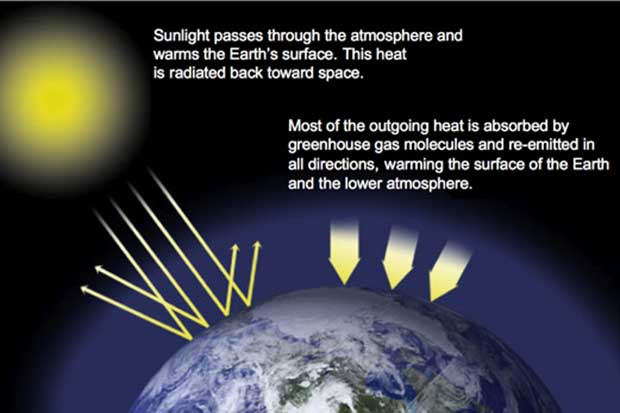Why does a blanket keep you warm?
Well, what goes on inside a blanket is pretty much like this: heat leaves your skin (your body radiates infra-red photons); heat is transferred to gas molecules in the air next to your skin; in order to escape, they have to traverse a tangle of fibres, so they are temporarily trapped.
To a gas molecule, a blanket is like a dense jungle. Heated air held in this layer is what keeps you warm. You provide the heat yourself, but instead of flying off, some of it hangs around next to your surface. A good thing too, because if it weren’t for this, humans would never have been able to inhabit the cooler regions of the world.
The fact that Earth wears a blanket was discovered nearly 200 years ago by some of the first people to study the way our planet absorbs solar energy and then radiates away an equal amount of its own.
By the time Burke and Wills set out in 1860, it was understood that the planetary blanket was made of two main things which act together, rather than independently: water vapour (water in gaseous form in the air) and carbon dioxide.
Of the two, water vapour is more abundant and powerful; CO2 is the prime determinant of Earth’s climate state over geological time. The two gases affect Earth’s climate by (almost literally) fixing the thickness of the blanket.
In the time humans have existed, there have been two “ice ages” or complete glacial cycles. During an ice age, when Earth gets progressively colder for about 80,000 years, the atmospheric blanket gets thinner.
The concentration of CO2 in the air falls to about 180 parts per million (ppm). When things warm up at the end of an ice age, CO2 rises to about 280 ppm. Under those geophysical conditions, that much change in CO2 is associated with a temperature difference of about 5 degrees.

In the last 20 years or so, scientists became aware of something very interesting about the last time Earth was in an “interglacial” – the warm interval between ice ages.
This period, usually called the Eemian, lasted between 131,000 and 116,000 years ago.
It’s interesting to researchers because before it ended, there was a natural warming, lasting some centuries. CO2 rose to 290 ppm, and the peak temperature was a bit warmer than it is now.
There’s some dispute about exactly how warm it got, but almost certainly, the peak was less than two degrees – at present the official target of our global response.
Studying the details of the Eemian, it’s been possible to show that the modest amount of warming caused enough polar melting to raise sea-levels by somewhere between 5 and 9 metres.
The reason why studies in different regions of the world give different estimates is still being worked out, but there is no question that the Eemian peak melted a lot of ice from the very same ice sheets that are vulnerable today – Greenland, the West Antarctic ice sheet, and some ice basins in East Antarctica.
Some studies suggest that in one phase the sea rose a couple of metres in a century.
Geophysical scientists of all sorts are working hard to try and see into the future, so they can tell us what to expect in a warming world. Atmospheric chemists, glaciologists, oceanographers, paleoclimatologists, mathematical modellers, and many more. And that’s a problem.
Their results are vital for making decent policy, but they’re scattered across so many disciplines that no clear picture of the climate future emerges by itself. It takes someone special to pull together the implications of multiple findings from field and laboratory and stitch them into a coherent story.
James Hansen has been doing this for years. Recently, with a group of colleagues, he published a major synthesis of current knowledge about the Eemian, making interesting suggestions about why the ice sheets responded as they did.

The paper has had its critics. Hansen and his team are only too aware that with the stakes so high, it’s necessary for scientists to be more assertive than usual, sometimes stretching their inferences enough to bother more reticent peers.
Be that as it may, one can hardly fault Hansen’s claim that if it is even reasonably probable that 2 degrees is not safe, we ought to be trying harder to avoid it.
One thing that worries Hansen is this: Earth’s “skin” isn’t like yours and mine, so when we muck around with the blanket, as we’re doing, strange things happen.
The atmosphere – that mantle of gases enclosing the solid Earth, is part of our planetary skin – but it also contains the blanket, which keeps the bottom layer of the air about 32 degrees warmer than it would be without it. And three-quarters of the planet’s surface isn’t solid at all – it’s water, which soaks up heat like a sponge.
It’s been calculated you could remove all the heat contained in the atmosphere (remember, that’s where we experience it) and fit it into the top 3 metres of the ocean.
Ocean heat moves. We’ve added vast quantities of heat to the global ocean – enough so that if it had all stayed in the air, we’d be 36 degrees warmer – and a lot of it has now gone into the deep.
Down there, it can have no effect on air temperature – but sooner or later it will resurface, and escape into the air under a blanket thicker than before.
This feature of Earth’s energy balance (called ocean thermal inertia) is what scientists mean when they say there’s a degree of committed warming “in the pipeline”.
It’s unavoidable because the heat is already in the surface system, just not apparent because it’s sequestered away from the air – for now.
Another of the authors’ concerns is understanding exactly how thick we’ve made the blanket in the last hundred years.
We know very precisely, thanks to the extraordinary deep Antarctic ice cores, that CO2 has never been above 300 ppm in the last million years.
We now have pretty good reason to believe it hasn’t been above 400 ppm (where it is now) for 3 million years; nor above 425 ppm (where it will be in a decade) for about 15 million years.
As far as we can tell, when all ocean heat has been redistributed (thermal equilibrium) a sustained CO2 at 425 ppm would produce sea-level rise of 25-40 metres.
Hansen’s plea is that we take these findings very seriously. They may not be final, but even provisionally, they ought to be part of our deliberations on the way to Paris.
Accumulated deep ocean heat, he says, means we will one day see Eemian-level warming. And if we do not take steps to trim that blanket, we could well return the Earth to conditions of the middle Miocene, 3 degrees warmer and every coastal town and city in the world under water.
We know what to do; we only need to want it enough.
Hansen’s paper can be read here.
* Dr John Davies is a retired GP, and runs a website called grandkidzfuture.com
Donate To New Matilda
New Matilda is a small, independent media outlet. We survive through reader contributions, and never losing a lawsuit. If you got something from this article, giving something back helps us to continue speaking truth to power. Every little bit counts.




